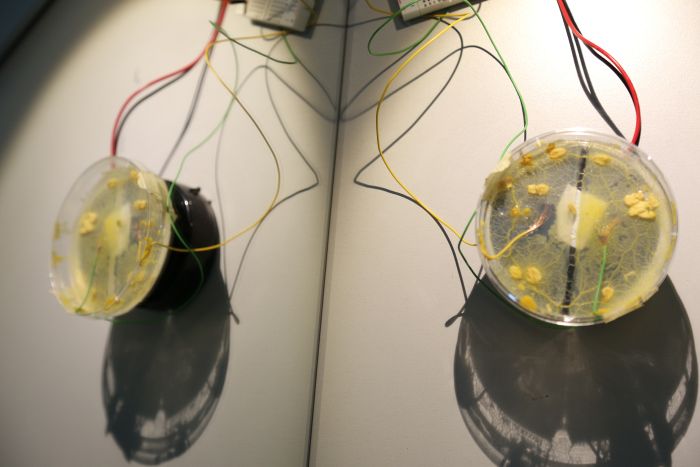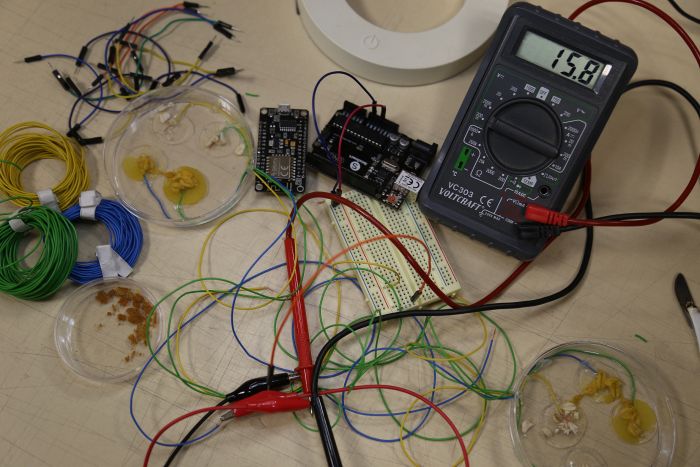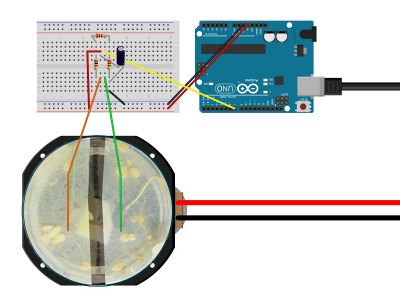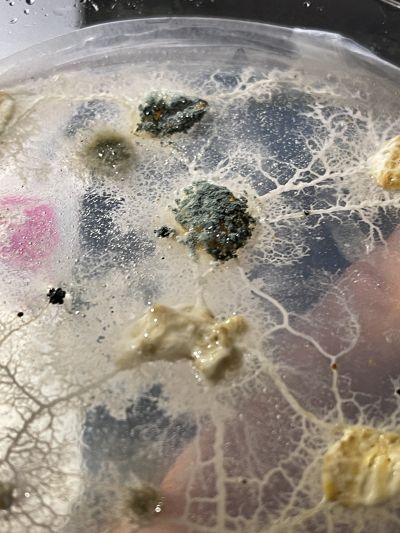No edit summary |
No edit summary |
||
| Line 49: | Line 49: | ||
# Now you are ready to listen to your slime mold | # Now you are ready to listen to your slime mold | ||
[[File:SPElec1. | ===Connecting the Arduino and Amplifier=== | ||
[[File:SPElec1.jpg|400px]] | |||
===Growing and Connecting Physarum Polycephalum=== | |||
<gallery> | |||
File:PPTogether1.JPG | |||
File:PPTogether2.JPG | |||
File:PPTogether3.JPG | |||
File:PPTogether4.JPG | |||
</gallery> | |||
==Arduino Source Code== | ==Arduino Source Code== | ||
| Line 181: | Line 190: | ||
After witnessing this process I started isolating them and put most of them in a cardboard box. Then the same happened. After that I tried to feed them with leaves that fell off one of my plants after moving to Weimar. First, it was curious to see what it was but immediately stepped back from it. After that I fed it again with oats, but unfortunately they all got contaminated and either formed spores or mold. | After witnessing this process I started isolating them and put most of them in a cardboard box. Then the same happened. After that I tried to feed them with leaves that fell off one of my plants after moving to Weimar. First, it was curious to see what it was but immediately stepped back from it. After that I fed it again with oats, but unfortunately they all got contaminated and either formed spores or mold. | ||
[[File:PPMold1.JPG|400px]] | |||
File: | |||
Another experiment was to see how the physarum conducts electricity. There were two problems I have been facing. One was that the voltage it conducted was in a range of millivolts. Second, the agar medium was also a good conductor, so my measurements were not very precise at that stage. Therefore, I transferred the to the cardboard to do experiments, but eventually they all „died“. | Another experiment was to see how the physarum conducts electricity. There were two problems I have been facing. One was that the voltage it conducted was in a range of millivolts. Second, the agar medium was also a good conductor, so my measurements were not very precise at that stage. Therefore, I transferred the to the cardboard to do experiments, but eventually they all „died“. | ||
<gallery> | <gallery> | ||
File: | File:DryPhysarum.JPG | ||
File: | File:PPMold2.JPG | ||
</gallery> | </gallery> | ||
Revision as of 21:52, 15 March 2022
SELF PLEASURE
Self Stimulation of Physarum Polycephalum
Experiment
The result of an experiment with Physarum Polycephalum and electricity has shown that it is not only a good conductor, but does produce a very small voltage during its growth. The voltage again is oscillating in the pattern of the plasma flow of the organism. The produced voltage and its resulting oscillation needs to be amplified to be able to be used, then send to an Arduino, where the frequency is calculated. Eventually, the signal is send through Serial into Processing, where the frequency is converted to an auditive frequency that can be played on a speaker and a graph that is shown on a screen. At the end, with an exciter speaker, the audio is fed back to the slime mold, to stimulate it. Like a feedback loop, or a self stimulation it interacts with itself and immediately giving the signal back to the computer.
This work questions the feelings of organisms such as Physarum Polycephalum and how it perceives stimulation or even pleasure. Although it is stimulating itself, it does not know it does so and did not even give consent. It is a very speculative and philosophical perspective on the world of organisms that have no brain or what we describe as consciousness.
The installation is showing a laboratory setting, where a petri dish is prepared with agar medium and electrodes. The cables lead into a box or machine with a screen that is showing the graph, the aesthetics of the box can be compared to an oscilloscope. When the slime mould is growing it closes the circuit and the millivolts are produced between the electrodes.
Instructions to build your own
- Prepare a petri dish with agar medium (2%)
- Weigh 100g of distilled water and add 2 grams of agar
- Cook the medium until it will thicken up
- Divide into Petri dishes or other containers that the surface is evenly covered
- Put two electrodes into the agar as long as it is still liquid
- As soon as the agar solidified divide/cut the agar in the middle, so the electrodes have two independent “agar-blobs” and are not in contact
- Now grow your Physarum Polycephalum
- Take two pieces of the dried specimen and use a pipette to put a few drops of water on it.
- Put each of the piece on one electrode.
- Now wait one or two days and be patient
- Meanwhile, build an amplifier, a good one to use is Martin Howse’s OP-amp (instructions) https://www.uni-weimar.de/kunst-und-gestaltung/wiki/images/Martin-howse.pdf
- Connect electrodes to amplifier and then the amplifier to your Arduino
- Connect your Arduino to your computer and upload the “Arduino Source Code” via the ArduinoIDE on your board.
- Paste the “Processing Source Code” in Processing
- You should now see this message:

- Then replace the number 0 in the line “String portName = Serial.list()[0];” to the number that is showing up like in this case the 3 before tty.usbserial: “[3] “/dev/tty.usbserial-****””
- In the last step before starting the program remove “//“ before “fullScreen();”
- Now you are ready to listen to your slime mold
Connecting the Arduino and Amplifier
Growing and Connecting Physarum Polycephalum
Arduino Source Code
Download the AduinoIDE here https://www.arduino.cc/en/software
#define pulse_in 7
int ontime,offtime;
float freq,period;
void setup()
{
pinMode(pulse_in,INPUT);
Serial.begin(9600);
}
void loop()
{
ontime = pulseIn(pulse_in,HIGH);
offtime = pulseIn(pulse_in,LOW);
period = ontime+offtime;
freq = 1000000.0/period;
Serial.println(freq);
}
Processing Source Code
Download the Processing4 here https://processing.org/download
import processing.serial.*; // import library for Serial communication
import processing.sound.*; // import sound library
Serial USBport;
String incomingData = null;
float rawSensorData;
float[] dataList;
int amount = 0;
float freq;
int xPos = 10; // horizontal position of the graph
SinOsc sine;
SawOsc saw;
Pulse pulse;
void setup(){
printArray (Serial.list()); //show Serial devices
//create fullscreen canvas with black background
//fullScreen();
background(0);
//open new port
String portName = Serial.list()[0];
USBport = new Serial(this, portName, 9600);
USBport.bufferUntil ('\n');
//create sine oscillator.
sine = new SinOsc(this);
sine.amp(0.5);
}
void draw() {
// multiply frequency by factor of 1.5 and play
freq = freq*1.5;
sine.play();
sine.freq(freq);
// create white line for graph
stroke(255);
line(xPos, height, xPos, height - freq);
// go back to the beginning when at the edge
if (xPos >= width) {
xPos = 0;
background(0);
} else {
// increment horizontal position
xPos++;
}
}
//get data from Serial port
void serialEvent(Serial USBport)
{
if (USBport.available() > 0)
{
String completeString = USBport.readStringUntil(10); // read the Serial port until there is a linefeed/carriage return
if (completeString != null) // only use String if there is valid data
{
trim(completeString); // remove whitespace characters at the beginning and end of the string
String seperateValues[] = split(completeString, ","); // split the string
freq = int(seperateValues[0]);
}
}
}
Old Concept
In terms of communication the internet has changed everything in our modern age. With cellular connections we are connected to our loved ones whenever and wherever we are. So why shouldn’t other organisms profit from this system? Do we know if there is a demand in the world of others? Or would they maybe even enjoy the freedom to be able to send signals to their peers?
Every organism has a cell communication to sense the environment, even humans do. As we are using a cellular communication to remotely talk to others, the cell communication in this case becomes cellular. In this experiment two or more Physarum Polycephalum(PP) are disconnected and isolated from each other and then reconnected by using an ESP WiFi module. An electrical voltage is measured from the organisms and then amplified. During the growth of the PP the plasma flow creates an oscillation in the voltage in shape of a sine wave, which can be used to stimulate the other slime mold and vice versa. This allows the two entities to communicate with their own electronic signals through a digital network.
In two separated fish tanks, a natural environment is created and prepared with electrodes to capture the voltage created by the PP. In between, the cables are running together in a machine, which displays the oscillation/pulses sent by each organism, before being sent to the other one.
This installation manifests the urge and exaggeration of communication living beings need and shows that not only humans can be interconnected by digital networks. But it also raises the question whether other organisms can communicate through electronic signals in a digital world.
First experiments to understand the organism
I’ve been trying to understand what’s good and what’s not so suitable for the growth of physarum polycephalum. I’ve been facing some issues during this strange ”relationship". The first intriguing thing the physarum did was when it “crawled” out of the petri dishes and connected to each other on my desk.
After witnessing this process I started isolating them and put most of them in a cardboard box. Then the same happened. After that I tried to feed them with leaves that fell off one of my plants after moving to Weimar. First, it was curious to see what it was but immediately stepped back from it. After that I fed it again with oats, but unfortunately they all got contaminated and either formed spores or mold.
Another experiment was to see how the physarum conducts electricity. There were two problems I have been facing. One was that the voltage it conducted was in a range of millivolts. Second, the agar medium was also a good conductor, so my measurements were not very precise at that stage. Therefore, I transferred the to the cardboard to do experiments, but eventually they all „died“.
Telecommunication between two physarum
In this experiment, I want to find a way to let two physarums interact through electronic devices. Two physarums will be in separate containers, the only connection will be through two ESP32s that will capture and transmit the state or other indicators to the other one.
Time lapse
Project ideas
Rewarding system for physarum
In my project I will be assessing physarum polycephalum to be used as a sensor. Every organism that contains water and minerals can be used as an electrical conductor and so does it work with physarum. Moreover, the behaviour of the slime mold will be captured through sensors to get a better understanding of it. After doing some experiments and understanding the organism better, the live captured data will be used to trigger something and kind of reward the slime mold to see how it reacts to it.















